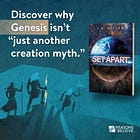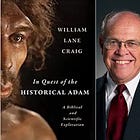Because of my research over the past decade into Genesis, I’m often asked by folks to answer questions about William Lane Craig’s model of human origins detailed in his book, In Quest of the Historical Adam. Several years back, Alisa Childers invited me onto her podcast to discuss Craig’s book. Here’s a clip from our conversation.1
In the years since this interview, more questions about Craig’s work have come out. The controversy that inspired this particular series was sparked by a FOX News articles published in 2022.
The Controversy
On January 2, 2022, FOX News published an article discussing the works of Joshua Swamidass and William Lane Craig. Both men have books that offer two distinct models of human origins but, despite the difference, both Craig and Swamidass are united in their effort to reconcile the biblical teaching about the historical Adam and Eve with the consensus science of animal to human evolution.
In the FOX news article, Fazale Rana, now President or Reasons to Believe, was critical of both models.
Fazale Rana, vice president of research and apologetics at RTB, told Fox News Digital that the models of Swamidass and Craig “both suffer from theological problems, despite their agreement with mainstream science.” Rana said that since the models do not consider Adam and Eve the sole progenitors of humanity, they “potentially put key Christian doctrines (such as human exceptionalism, the Fall, Original Sin and the Atonement) in harm’s way.”
The article offers little context for this quote, but William Lane Craig took exception to Rana’s criticism. In his January 10, 2022 podcast, News Coverage on Dr. Craig’s Book, In Quest of the Historical Adam, Craig didn’t refute Rana’s claim with a specific quote from his book but instead he argued that Dr. Rana was a sloppy and careless thinker who didn’t read his book. At the 11 min mark, Craig said,
I thought these statements were really sloppy on his part. It’s evident that he has not read my book because my book defends the universal progenitorship of Adam and Eve: that every human being who has ever lived on face of this planet is descended form this primordial couple. I defend the historicity of the fall into sin. And so it is perfectly consistent with the doctrine of original sin… if one wants to affirm that. I think that he [Rana] was being very careless in his accusations.
Did you catch the subtle change in language? Rana’s reported critique used the language of “sole progenitorship” but Craig defended his commitment to “universal progenitorship.” So did Craig refute Rana’s claim or sidestep it?
The Question
Here’s the question about Craig’s model of human origins that I want to explore:
“Does Craig believe that Adam and Eve are historical people, the first humans, and the ancestors of every human who’s ever lived?”
It seems like a simple question, but discerning Craig’s answer is more complex than you might imagine.
If by this question folks want to know, does Crag believes Adam and Eve were the first two humans in history, then his answer is yes. If the question, however, concerns Craig’s belief about Adam and Eve as the sole biological progenitors of every human, then his answer is, at best, unclear for two reasons.
First, some of Craig’s definitions are peculiar to his theory and differ from how others use these same words. Second, Craig’s effort to align Genesis with the modern theory of animal to human evolution leads him to create concordist terminology which, again, does not easily align with other theologians or traditional readings of the Bible. Neither of these issues make Craig’s model wrong, but they do make his argument difficult to pin down.2 So, if you get a little confused reading Craig’s book (or reading my analysis), don’t worry, you’re not alone.

With that challenge in mind, I’ve put together a rather lengthy response that I’ll break down into several shorter posts. First, let me summarize Craig’s model.
Craig’s Model of Human Origins
For those new to Craig’s book, let’s start with a basic overview of his model of human origins. I’ve summarized Craig’s theory in other articles but for this post, Guy Prentiss Waters’ summary is excellent.
Craig argues that Adam and Eve were “members of Homo heidelbergensis [Neanderthals],” a “species that may have originated … prior to 750,000 years ago,” and “the founding pair at the root of all human species” (359). As such they are “the fount of all humanity, the genealogical ancestors of every human being who has ever lived on the face of this planet” (363). Adam and Eve themselves “emerged from a wider population of hominins” who were not human beings (376). A “radical transition effected in the founding pair that lifted them to the human level plausibly involved both biological and spiritual renovation, perhaps divinely caused” (ibid.). It is at that juncture that they become “responsible moral agents” and subsequently “misuse their free will by choosing to commit a (the original) sin or transgression, thereby becoming morally guilty before God and alienating themselves from God, though not from the offer of God’s love and forgiveness” (378, 379). “Adam was thus responsible for introducing spiritual, but not physical, death into the human race, since as biological organisms Adam and Eve were naturally mortal” (379).3
Waters’ summary is solid, but because terms like “fount,” “root,” and “genealogical ancestry” are not used in the Bible, some readers may find Craig’s model confusing. For further clarity, check out this clip where Craig explains his view to Sean McDowell.4
Craig’s Two Adams
For Craig, the Adam we read about in the Bible (literary Adam) is different from the historical Adam we discover through science. The evidence for animal to human evolution, Craig believes, requires a new interpretation of the literary Adam that accommodates the consensus science. Craig reconciles the two Adams this way,
Given that all human beings are descendants of a founding couple—a theological, not a scientific, commitment—Adam and Eve may be plausibly identified as belonging to the last common ancestor of Homo sapiens and Neanderthals, usually denominated Homo heidelbergensis (p. 363).

Craig’s model of human origins, therefore, is an “attempt to integrate the independently discovered findings of contemporary science and biblical theology into a synoptic worldview (16).” Craig's model treats the historical Adam and Eve as members of Homo heidelbergensis who underwent a radical biological and spiritual transformation, making them the first humans and the “genealogical ancestors” of all people (we’ll come back to that term genealogical in the next post).5
Origins Model 1 is my effort to illustrate Craig’s view that evolutionary forces spawned a group of pre-human animals. From this group of hominins came the first two humans, Adam and Eve, who become the universal progenitors of every soulish human.
Careful observes will wonder why I include the “Evolved Biological Woman” with the question mark in the ancestral tree of Soulish Humanity. That is the point of contention that I’ll address in a future post alongside Craig’s theology of the “soul” and his scientific theory of “genealogical” ancestry. For now, I’d like to focus on Craig’s view of the textual Adam.
Craig’s Mytho-Hermeneutic
Craig supports his model of God-directed animal to human evolution using a novel mytho-historical hermeneutic which he claims is necessary for two reasons.
First, because too many Christians are in crisis because their trust in the consensus science has made them question the Bible.
What especially moved me to undertake this study was the sense of the deep spiritual crisis many young Christians experience when they discover the scientific evidence concerning human origins. I wanted to help them see that they need not abandon the Christian faith because of their scientific knowledge (p. xii).
Second, because the stories of Genesis 1–11 are too fantastical and full of inconstancies (such as anthropomorphisms) to be used for “serious” theology.
Finally, do the primaeval narratives exhibit fantastic elements and do they remain untroubled by logical contradiction or incoherence? It seems that on both counts the primaeval narratives do share this family resemblance of myths, even if to several orders of magnitude less in comparison to ANE polytheistic myths (101).
Given this staring point, Craig concludes,
If Gen 1–11 functions as mytho-history, then these chapters need not be read literalistically. Some of the accounts, such as the origin and fall of man, are clearly metaphorical or figurative in nature, featuring as they do a humanoid deity incompatible with the transcendent God of the creation story. Others, as we have seen, would be fantastic, even to the author himself, if taken literally (198).6
Craig’s view of Genesis is also summarized by him in this short clip.
Crag’s mytho-hermeneutic (as I call it) makes the following three distinctions:
the “literary Adam” is distinct from the “historical Adam (206),”
“truth” about the story is distinct from the “truth-in-a-story (207),” and
New Testament authors can use Genesis “illustratively” or “assertorically (206).”
Given these three distinctions, the following quote helps us better understand Craig distinction between the textual and historical Adams.
we can see how naive it is to argue that because some NT author refers to a literary figure, whether found in the OT or outside it, therefore that figure is asserted to be a historical person, much less is a historical person (221).
In a previous post, I addressed Craig’s claim that Christians who don’t use his approach are naive. In part, here is what I wrote.
To bolster his case, Craig notes that several NT authors cite mythical peoples to make theological points. Given this use of fiction to shape theology, Craig says it is believable that Paul’s references to Adam in no way commit him to truth statements about the historical Adam, but only truths about a literary Adam. Craig writes in #749 NT Authors’ Attitude toward the Primaeval History, “This distinction between the authors’ beliefs and their teachings is perfectly plausible and is commonly accepted.”
A lot more could be said about Craig’s hermeneutical assumptions but much of it goes beyond the focus of this post. However, I’d encourage you to read more about Craig’s mytho-hermeneutic here in my interview with John Oswalt or pick up Guy Prentiss Waters’ article linked in the footnotes.
Even without a deep dive into Craig’s mytho-hermeneutic, the information I’ve provided so far should give most readers a sense of Craig’s views of the textual Adam found in both the Old and New Testaments.
Up Next
Armed with this information about Craig’s historical and textual Adams, we can now turn back the original question,
“Does Craig believe that Adam and Eve are historical people, the first humans, and the ancestors of every human who’s ever lived?”
In my next post, I’ll unpack more of Craig’s unique definitions and what each word tells us about his origins model. In the meantime, paid subscribers are invited to continue the conversation in the comments section. Feel free to ask me questions or respond with your own concerns.
William Lane Craig's Two Adams (Part 2)
In part 1, I introduced William Lane Craig’s book, In Quest of the Historical Adam. Craig believes that his novel genre of mytho-history allows the modern reader to reconcile the biblical account of God’s creation with both the de novo creation of Adam and Eve
You can find the full YouTube video, Is Genesis Compatible with Evolution?, here. My other appearances on the Alisa Childers podcast are, Does a Belief in a Historical Adam and Eve Matter to Christianity?, and Is the Baptism of the Holy Spirit a Core Essential Doctrine?
Craig gives three definitions of concordism in his book and argues that his view aligns with definition number three. I disagree with Craig and think his argument actually fits with definition number two. Here is what Craig writes, and you’ll have to decide for yourself which one fits his origins model. Craig writes, “Following Denis Alexander, we may distinguish three ways in which the word concordism has been used: (1) the attempt to extract modern scientific information from scriptural passages—for example, taking Gen 1:1 to teach big bang cosmology; (2) the attempt to interpret scriptural texts in light of modern science—for example, day-age and gap interpretations of Gen 1; and (3) the attempt to integrate the independently discovered findings of contemporary science and biblical theology into a synoptic worldview (16).”
Waters, Guy Prentiss. "William Lane Craig, Theistic Evolution, and the New Testament." Presbyterion 50, no. 1 (2024): 55.
The clips used in this post originally aired on my podcast Off the Cuff.
See Rana’s critique of Craig’s science in his published article, Who Was Adam?: A Critical Assessment of William Lane Craig’s In Quest of the Historical Adam. The essence of Rana’s critique is this,
Craig is to be commended as a philosopher and theologian for his willingness to engage the scientific literature in his quest to discover the historical Adam (and Eve). In many respects, he does an admirable job handling the insights that come from the published work in physical anthropology and archaeology. And, to be fair, the conclusions he draws about the shared cognitive capacity of H. heidelbergensis, Neanderthals, and modern humans are held by many paleoanthropologist. Nevertheless, Craig sidesteps a significant number of studies that count against his model (which locates Adam 750,000 to 1,000,000 years ago as a member of H. heidelbergensis), ignoring the views of paleoanthropologists who regard anatomically and behaviorally modern humans as fundamentally different from the other hominins. That is to say, Craig disregards the perspectives of a growing number of primatologists, evolutionary anthropologists, and evolutionary psychologists who regard human beings as exceptional. When these studies—which are interpreted as evidence for human exceptionalism—are weighed appropriately, Craig’s model becomes much less convincing and much less tenable (7).
There is an ironic inconsistency here for Craig’s hermeneutic. Craig, alongside Paul Copan, in their book Creation Out of Nothing: A Biblical, Philosophical, and Scientific Exploration, takes the “primaeval narratives” of Genesis 1 quote “literalistically” and believe that God has a voice and spoke the world into existence out of nothing. So while Craig argues creatio ex nihilo should be taken literally, scholars like John Walton argue that Craig’s interpretation is concordist and woodenly literalistic. Walton concludes that Craig’s interpretation is a product of his acceptance of the modern scientific worldview that places an inordinate concern on material origins (see, Walton, The Lost World of Genesis One, 42.). Harry Lee Poe supports Walton’s conclusion by suggesting scholars like Craig who reject the language of Genesis 1 as figurative are assuming literal language has greater hermeneutical value and have misunderstood the message of the Bible.
By assuming a literal meaning to the opening chapters of Genesis, conservative theologians imposed a theory of science necessary to salvation. As we move into a new century, perhaps we can learn an old lesson from Augustine. If our message is tied too closely to any particular theory of science, then when new scientific theories come, our message will be discarded with the old science. On the other hand, if our message cannot transcend the shifts in science from a flat earth sitting on four pillars, to the earth-centered world of Ptolemy, to the sun-centered solar system of Copernicus, to the mechanical universe of Newton, to the relative universe of Einstein, then perhaps we have misunderstood the message of the Bible (Poe, “Evangelism in Light of Modern Science,” Review and Expositor 105, no. 4 (2008): 500).
This illustrates the critical flaw in Craig’s mytho-history: one man’s fantastical is another man’s literal. Which “expert” is right, Craig or Poe? Craig’s mytho-hermeneutic only works because Craig sets himself up as the "expert” who decides where to draw the line.










